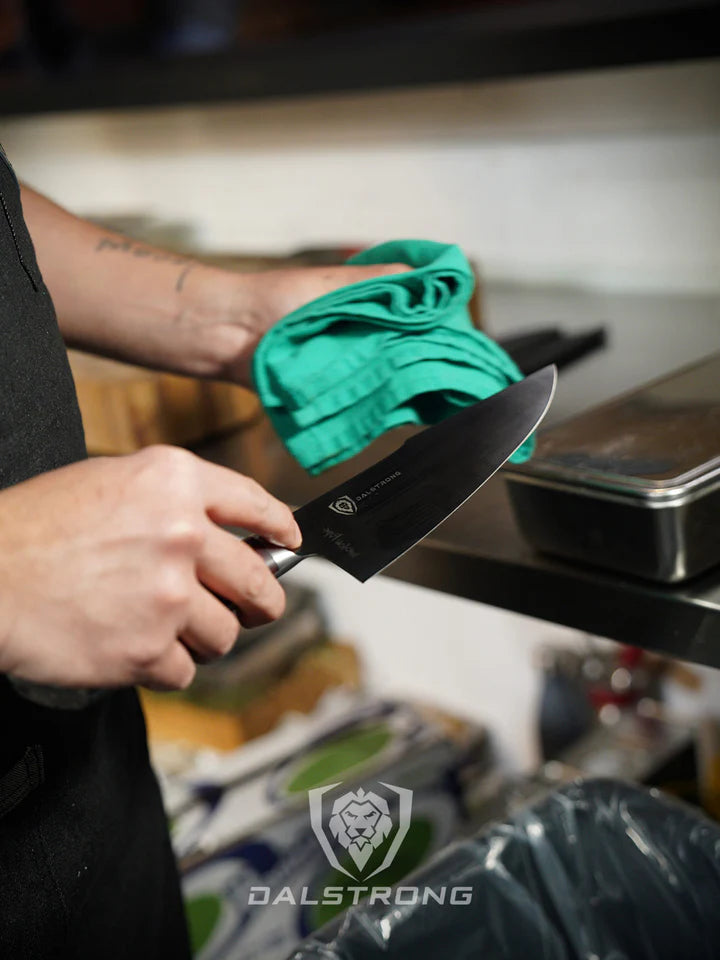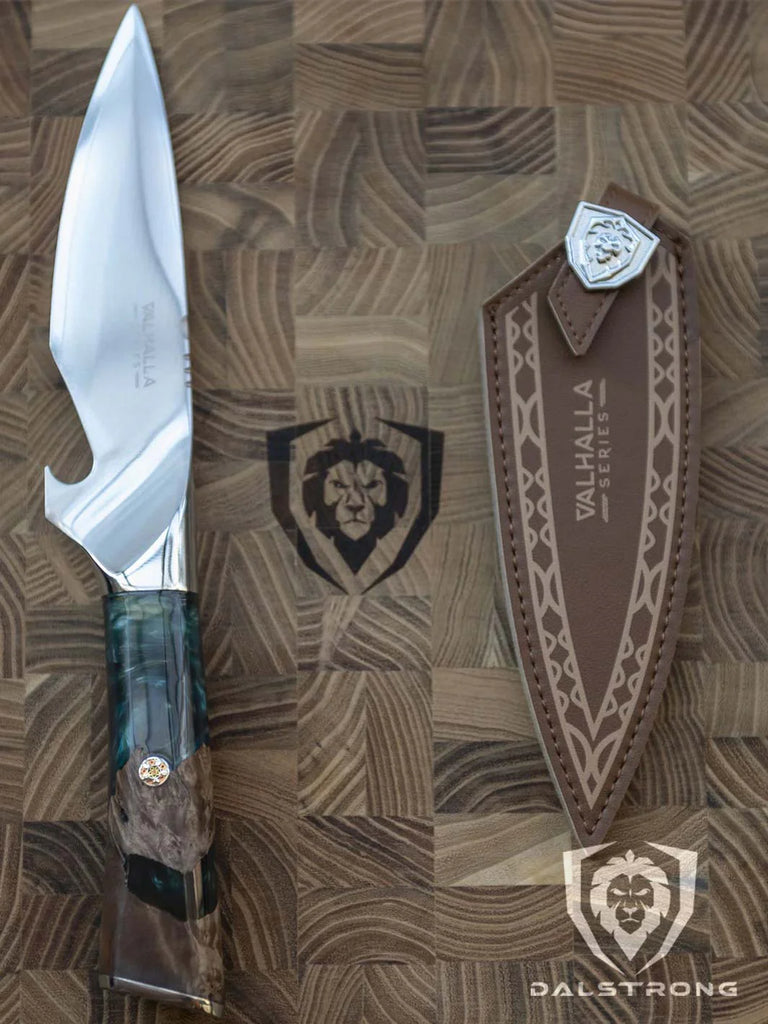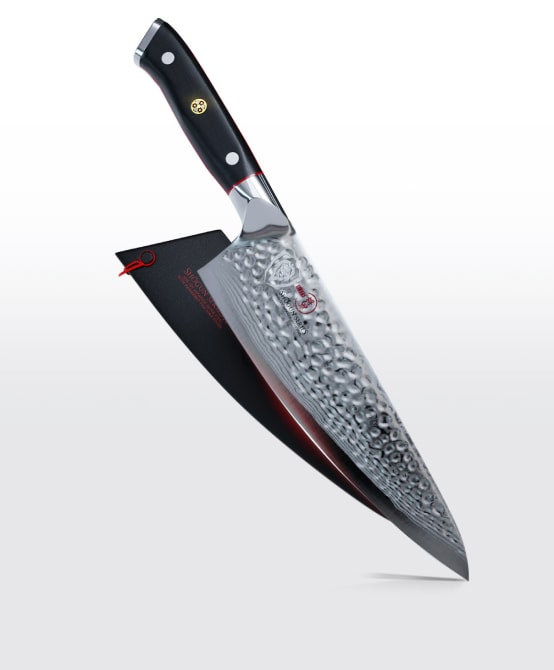 Valhalla Series Chef's Knife 8"
Valhalla Series Chef's Knife 8"
A knife must be cleaned and sanitized immediately after use, especially when switching between different types of food like raw meats and vegetables, to prevent cross-contamination. Additionally, it should be sanitized every four hours during continuous use to ensure it remains safe and hygienic.
1. Why Is It Important To Clean And Sanitize Knives?
 Spartan Ghost Series Chef's Knife 8"
Spartan Ghost Series Chef's Knife 8"
You know, keeping your kitchen knife sparkling isn't just about making it Instagram-ready. It’s a crucial practice in food safety. Think about this: every time you chop, dice, or slice, tiny food particles get left behind on your knife blades. And while a little bit of onion stuck to the blade might not seem like a big deal, these remnants can be a playground for harmful bacteria.
Imagine you’ve just prepped chicken for a spicy stir-fry, and those invisible bits of chicken goodness (or, technically, food residue) are still clinging to your knife. Now, if you switch to chopping vegetables with the same knife without cleaning knives thoroughly, you’re setting the stage for cross-contamination. This is where foodborne illnesses like salmonella can invite themselves to your dinner. Not the guest you want, right?
Why clean and sanitize?
Here’s where sanitizing knives comes into play. It’s not just a rinse under warm water; it’s about really paying attention to removing all those food particles and making sure the knife is sanitized properly to kill off any germs. This means scrubbing the knife to get rid of any visible food residue and then following up with a sanitation method that ensures the knife is safe to use again.
So why is it important? Because keeping your knives clean and sanitized means you're not just cooking; you're taking care of the health of everyone who eats your food. Properly cleaning knives and sanitizing knives isn’t just a chore -- it's a responsibility, one that ensures your kitchen is a safe place to whip up that next delicious meal. Plus, it extends the life of your knife blades, keeping them sharp and ready for action, meal after meal.
Remember, a clean knife is a happy knife. Wait… does that work? Knives aren't sentient. In any case, we want to make sure we have healthy, delicious meals without any unwanted microscopic party crashers. From regularly cleaning your steak knife set to mastering deep cleaning your multi-purpose kitchen tools, keeping your cutlery in pristine condition is more than just ensuring food safety; it's about crafting a culinary masterpiece free from unwanted extras. So remember, a little knife cleaning goes a long way to preventing cross-contamination and ensuring food joy. Happy slicing!
2. At What Point Should A Knife Be Cleaned And Sanitized?
 Valhalla Series BBQ Piranha Knife 6"
Valhalla Series BBQ Piranha Knife 6"
Knowing when to clean and sanitize knives is as crucial as knowing how to wield them. Each cut -- whether through cutting meats or slicing through crisp cutting fruits -- leaves behind more than just a neat chop; it potentially leaves microscopic leftovers that could invite bacteria. That's where smart knife hygiene comes into play.
Take this scenario: You've just finished prepping some raw meat poultry, and now you're about to start on vegetables for a salad. This is a textbook moment to pause and perform a proper cleaning of your knife. Why? Because cross-contamination isn't just a buzzword; it's a real kitchen hazard. Transferring bacteria from meat to veggies can turn a healthy meal into a health scare.
How about continuous use?
And what about those long cooking sessions -- perhaps a holiday feast or meal prep for the week? It's easy to lose track of time, but here's a rule you can't forget: clean and sanitize knives at least every four hours of continuous use. This isn't just playing it safe; it's playing it smart. Regular sanitation breaks ensure that any potential buildup of food residue and bacteria is promptly addressed, keeping everything that comes off your cutting board safe to eat.
Incorporating sanitizing solutions into your cleaning regimen after heavy use is like giving your knife a mini spa treatment. It rejuvenates and prepares it for the next task, ensuring that the only things your knife is cutting are the ingredients for your recipes -- not corners on safety.
The bottom line
So, when should you clean that knife? After every single use, no exceptions. Making this a habit might seem like a bit of a chore, but it's a fundamental part of kitchen discipline. Stick to this routine, and you'll not only keep your dishes safe but also extend the life of your kitchen knives, ensuring they remain as precise and effective as the day you bought them.
3. How to Clean and Sanitize Your Knife
Cleaning and sanitizing your knives isn't just a step in your cooking routine -- it's an art and a science, combined in a splash of soapy water and a dash of sanitizing solution. It's simple, sure, but doing it right takes a bit of know-how and a whole lot of diligence.
First things first
Grab some mild dish soap and warm water. This is your go-to duo for initial cleaning. This is the prep work before painting -- essential for a good finish. Scrub those blades and handles thoroughly, paying particular attention to any nooks where food particles like to hide. It's like brushing your teeth; you wouldn't just scrub the front and call it a day, right?
After that, it's crucial to dry the knife thoroughly. This isn't just about avoiding water spots; leaving moisture on your knife, especially if it’s a steak knife or wooden knife, can lead to rust and deterioration. Think of it as tucking your knife into bed, nice and dry, so it doesn't catch a cold (or, well, rust).
Chemical sanitization
This isn't just wiping down with any old cleaner; you want to use a sanitizer approved for food contact surfaces to ensure your knives are not only clean but safe from any microbial invaders. This step is your knight in shining armor, rescuing your kitchen from unseen bacterial beasts lurking on your cutting edges.
Always remember to follow the manufacturer's instructions when it comes to both cleaning agents and methods. Each knife is a bit different, and what works for one might be overkill -- or underwhelming -- for another. This is especially true for those with knife blocks, where improper care can lead to damage not just to one, but to all of your culinary blades.
Incorporating these steps into your routine ensures that every slice, dice, and chop comes from a knife that's not just clean but sanitized. It's like giving yourself a high-five after a workout -- because when your tools are clean, your cooking environment is safe, and your mind can focus on the fun part: creating delicious dishes. So, lather, rinse, sanitize, and repeat -- your knives deserve it!
Read about the best way to store your knives, here.
4. Must-Have Dalstrong Knives
1. Shogun Series ELITE | Chef's Knife 8"
This knife is a serious game-changer in the kitchen. It’s got a Japanese Super Steel core and is layered with 66-layer Damascus, making it not only super sharp but also incredibly durable. Whether you’re dicing veggies, slicing meats, or just chopping up some herbs, this knife handles it all with ease.
PROS:
- The Aus10V Japanese Super Steel core keeps the blade super sharp, so you can slice through anything like butter.
- It's not just sharp; it's also stunning with a 66-layer Tsunami Rose Damascus pattern that you'll want to show off.
- The tapered bolster gives you a comfy grip and great control, making long prep sessions a breeze.
- Thanks to the military-grade G10 handle, it’s tough, stays cool, and keeps your grip secure, even when things get hectic.
CONS:
- This might be more knife than you need if you’re just a casual chef who sticks to basics.
- If you're looking for a knife to make more precise, detailed work, maybe look into a paring knife like the next one in this list…
2. Gladiator Series | Paring Knife 3.5"
This little paring knife is specifically designed for those fiddly tasks that a bigger chef's knife just can’t handle. Think peeling apples, mincing garlic, or getting artistic with some fancy garnishes. It's super precise, making it a go-to for adding those fine touches that make your dishes pop.
PROS:
- Crafted from high-carbon German steel, it’s built to last and keeps its edge for all those precise cuts.
- The blade's got a bit of extra height, so you don't have to worry about banging your knuckles while chopping.
- It’s pretty low maintenance — just a quick hone now and then and it’s back to peak performance.
- The handle is not only tough and durable thanks to the laminated G10 Garolite but also shaped to fit your hand just right, making it easy to maneuver.
CONS:
- If you’re used to more heavyweight knives, this one might feel a bit too light for your liking.
- While it’s perfect for the small stuff, you’ll need to switch to a larger knife for the heavy-duty chopping.
3. Valhalla Series | Slicing & Carving Knife 12"
This slicing and carving knife is a real showstopper. Designed to handle everything from your Thanksgiving turkey to Sunday roast beef, this 12-inch blade slices through meat like it’s butter. It’s forged from high-carbon stainless steel and sports a unique, eye-catching celestial handle – each one a unique piece thanks to the special resin-mixing technique.
PROS:
- The 12" blade is not just long but also precision-forged from 5-layer stainless steel, ensuring durability and a smooth slice every time.
- Its super sharp edge is hand sharpened to 8-12° per side, making slicing fast and effortless, without any tugging or tearing.
- Despite its size, the knife is surprisingly lightweight, thanks to the controlled hybrid bolster, which makes handling it a breeze.
- The unique handle isn’t just beautiful; it’s also made from stabilized wood and resin, making it resistant to heat, cold, and moisture, perfect for any kitchen environment.
CONS:
- The impressive length and specialized design mean it might be overkill for everyday, smaller kitchen tasks.
- The unique, ornate handle may require more care than your typical kitchen knife to maintain its appearance over time.
4. Gladiator Series R | Meat Cleaver 9" with Stand
This thing is, for lack of a better word, a beast. Forged from tough high-carbon steel, it's basically your go-to for when you need to chop through tough meats or even bones. It's heavy, coming in at nearly 3 lbs, and has a thick, 6mm spine, so it really lives up to its name. Plus, it comes with a cool stand, so it looks pretty epic sitting on your counter.
PROS:
- It's built with high-carbon 7CR17MOV steel, so it’s super durable and ready to handle the heavy-duty chopping.
- The 9-inch blade and thick design make it perfect for getting through those tougher kitchen tasks like a champ.
- The G10 Garolite handle is tough, but also comfy to hold, which is great when you’re dealing with a heavier cleaver.
- That stand it comes with makes storing this big guy a lot easier and safer.
CONS:
- If you're not someone who needs to chop through a lot of thick meats or bones, this might be more cleaver than you actually need.
- It’s not the best choice for finer, more precise kitchen tasks, so you might need to keep a smaller knife around for that stuff.
5. Frost Fire Series | Bread Knife 8"
Got a freshly baked loaf or a ripe watermelon that needs slicing? Grab the Frost Fire bread knife. It’s not just for bread; this blade is a champ at slicing through anything big and delicate without squashing or tearing. Plus, it looks super cool with its icy, frosted finish and feels just as good in your hand, thanks to its lightweight, ergonomic design.
PROS:
- The blade is made from 7-layer high-carbon steel with a sandblast finish, which isn't just about looks – it helps keep anything from sticking.
- Those serrated teeth are seriously sharp, perfect for slicing through softer foods without crushing them, thanks to expert sharpening.
- The handle isn’t just stylish with its white resin and honeycomb finish; it’s also designed for a comfy, secure grip no matter what you're slicing.
- It's super lightweight, which means your hand won’t tire out, even when you’re prepping for a big meal or get-together.
CONS:
- While it’s great for delicate and soft foods, this isn’t the knife you’d grab for heavier, tougher cutting jobs.
- The unique, stylish look might not be everyone’s cup of tea if you prefer more traditional kitchen tools.
5. Frequently Asked Questions
When should a knife be cleaned and sanitized?
Knives should be cleaned and sanitized right after use. And don’t forget, after handling raw meats, a quick clean can keep the nasties at bay.
When must a knife be cleaned and sanitized after 4 hours of constant use?
The best move is to always sanitize your knife immediately after using it. Make that knife sparkle like new, especially during marathon cooking sessions.
When should you clean and sanitize a knife quizlet?
Whenever your culinary quests involve different types of food, especially switching from proteins to produce, make that swap a clean one.
When should you clean knives?
After every use, or if left idle, at least before the next culinary adventure to maintain a hygienic cooking environment.




















































































































































































































































































































